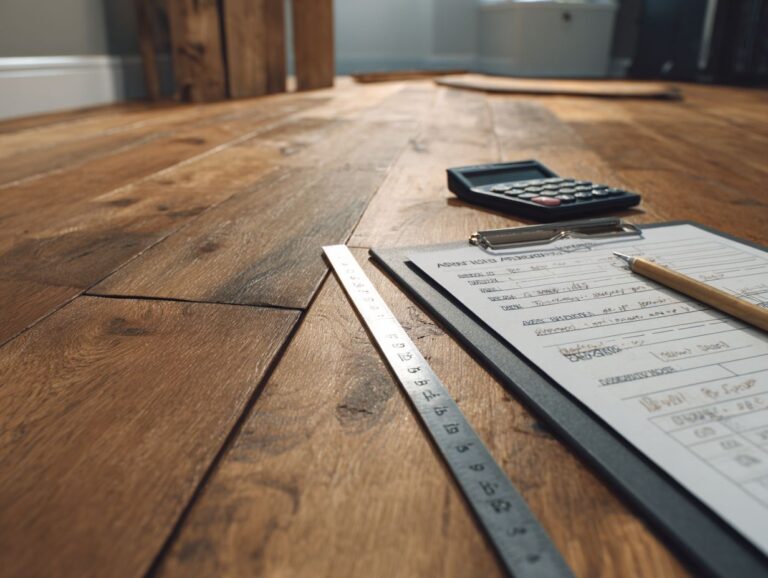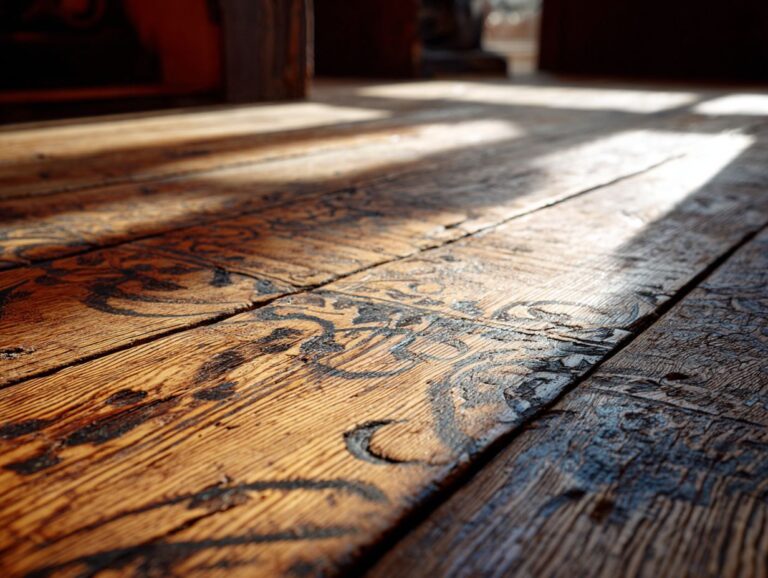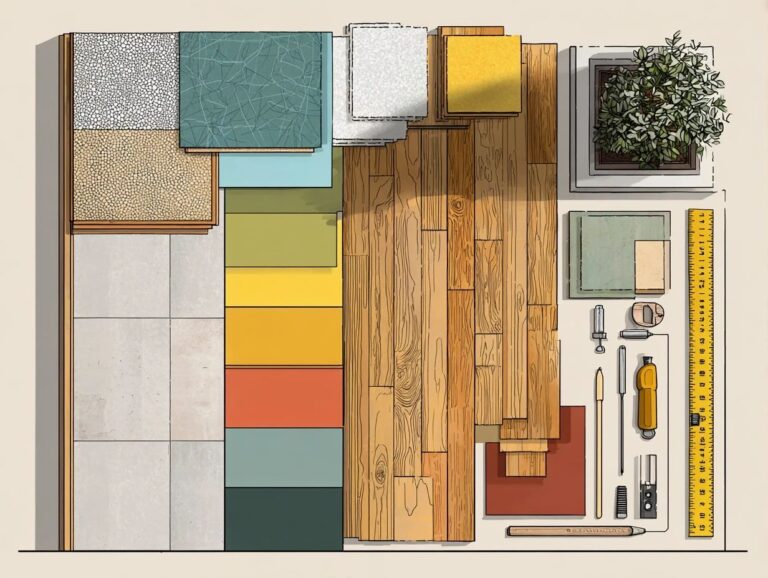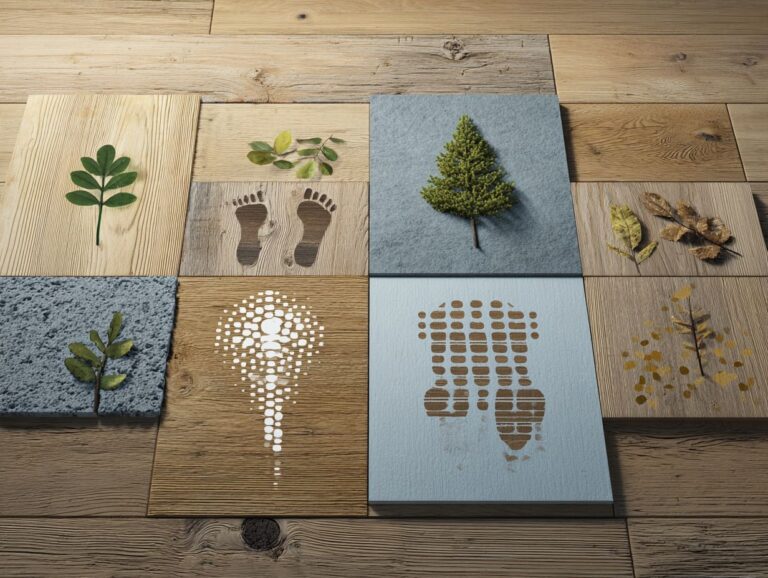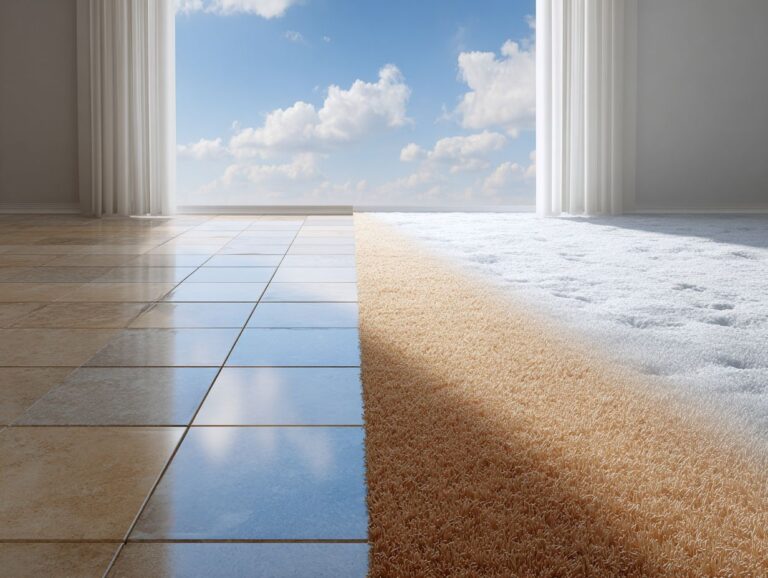Radiant Heat Compatible Flooring – Safe Options
Want to improve your home’s comfort and energy use? Radiant floor heating systems, whether hydronic or electric, are becoming increasingly popular for their ability to provide even warmth. However, making sure your flooring matches is important for saving energy and meeting installation requirements. This guide will look at flooring choices that pair well with radiant heating, allowing you to make a warm space without any sacrifice.
Key Takeaways:
Contents
- Radiant Heat Flooring Energy Statistics
- Types of Radiant Heat Systems
- Importance of Flooring Compatibility
- Safe Flooring Options for Radiant Heat
- Floors to Avoid with Radiant Heat
- Installation Considerations
- Maintenance of Radiant Heat Compatible Flooring
- Frequently Asked Questions
- What is radiant heat and why is it important for flooring options?
- What are some safe flooring options for radiant heat systems?
- Can traditional hardwood flooring be used with radiant heat systems?
- Are there any carpet options that are safe for radiant heat systems?
- Do I need to make any special considerations when installing radiant heat compatible flooring?
- Is radiant heat compatible flooring more expensive than traditional flooring options?
What is Radiant Heat Flooring?
Radiant heat flooring is a system that delivers heat directly to the floor surface through either hydronic or electric methods, ensuring even heat distribution throughout a space.
Hydronic systems move hot water through pipes under the floor, which makes them a good choice for covering big spaces and newly constructed buildings.
Electric systems, often easier to install, use heating cables or mats and are perfect for smaller spaces or remodels.
Common uses include home bathrooms, kitchens, and basement updates, where heated floors increase comfort.
Homeowners generally save money on energy bills because of good heating systems, especially when they use smart home gadgets to control the temperature. Worth exploring: Energy-Efficient Flooring – Utility Savings Analysis for more insights on optimizing utility costs.
Benefits of Radiant Heat Systems
Radiant heat systems can increase the comfort level of homes while providing significant energy savings, often reducing heating costs by up to 30% compared to traditional systems.
These systems work by warming the surfaces of a room rather than just the air, promoting a more even and comfortable temperature.
For example, electric radiant floor heating is highly efficient for smaller spaces, while hydronic systems, which use hot water, are ideal for larger homes.
The Department of Energy says radiant heating can make your home more comfortable and save energy, helping create a more eco-friendly living space.
Aesthetic appeal is another benefit; with no visible vents or radiators, interior design remains unobstructed, allowing for greater flexibility in decor.
Radiant Heat Flooring Energy Statistics
Radiant Heat Flooring Energy Statistics
Energy Consumption and Costs: U.S. Residential Electricity Usage Breakdown
Energy Consumption and Costs: Bathroom Floor Heating
Energy Consumption and Costs: Monthly Operating Costs
The Radiant Heat Flooring Energy Statistics gives a detailed overview of energy use and expenses linked to different household heating and cooling methods in the U.S., concentrating on bathroom floor heating. Knowing these statistics is important for homeowners who want to improve energy use and lower utility bills.
In the U.S. Residential Electricity Usage Breakdown, space heating and water heating each account for 12% of residential electricity use, while cooling/air conditioning comprises 19%. The remaining 54% falls under other uses, which includes lighting, appliances, and electronics. This distribution highlights the significant share that heating and cooling demand in total energy usage, offering potential areas for efficiency improvements.
- Bathroom Floor Heating: This system covers 60% of the bathroom’s floor area, consuming approximately 2.88 kWh daily and 86.4 kWh monthly. Knowing how much energy radiant heat uses can help you enjoy its comfort while keeping an eye on expenses.
Monthly Operating Costs reveal that bathroom floor heating incurs a modest cost of $14.05, notably lower than other heating and cooling options, such as the water heater at $66.78, the portable heater at $59.38, and the air conditioner at $55.47. These comparisons demonstrate the economic advantage of efficient radiant heating systems.
The data suggests that integrating radiant heat flooring, particularly in high-usage areas like bathrooms, provides a cost-effective solution for reducing overall heating expenses while maintaining comfort. Using radiant heat in homes can help save money and use energy effectively, making it a good choice for homeowners looking to manage energy costs.
Types of Radiant Heat Systems
Knowing about the various types of radiant heat systems is important for choosing the best option for your home, whether you are considering electric or hydronic systems.
Electric Radiant Heat Systems
Electric radiant heat systems use heating cables or mats placed under floors to create warmth. They work well for small spaces or when updating a building.
These systems are particularly effective in bathrooms or kitchens, providing direct warmth where it’s needed most.
For installation, expect a cost of around $5 to $10 per square foot, influenced by the complexity of the project and local labor rates.
A highly recommended product is the Warmly Yours system, known for its reliability and ease of installation.
Start by checking what kind of floor you have, then talk to an expert to make sure it’s installed well, improving both comfort and energy use in your room.
Hydronic Radiant Heat Systems
Hydronic radiant heat systems circulate hot water through pipes embedded in the floor, offering a highly efficient method of heating larger spaces with consistent warmth.
These systems offer many advantages, such as saving energy and lowering operational expenses.
Energy efficient because they typically operate at lower temperatures compared to forced air systems, they can reduce heating bills by up to 30%.
Initial costs for installing hydronic systems average between $6 to $12 per square foot, depending on the components chosen.
Important equipment consists of a high-performance boiler to heat the water and pumps to make sure the water spreads evenly.
Using a programmable thermostat can help reduce energy use and lower costs.
Importance of Flooring Compatibility
Picking the right flooring materials is important for getting the most out of radiant heat systems and ensuring good heat transfer. For a deeper understanding of installation essentials, our guide on Flooring Underlayment Installation – Types and Methods provides valuable insights.
Heat Transfer Efficiency
The ability of flooring materials to transfer heat impacts the efficiency of radiant heating systems. Tile and natural stone transfer heat more effectively.
Tile is commonly used in construction because it transfers heat effectively, with a thermal conductivity of about 1.5 W/m*K, making it suitable for radiant heating systems.
Natural stone, such as granite, typically ranges from 2.5 to 4.0 W/m*K, further enhancing heat energy absorption and distribution.
Wood flooring, having a thermal conductivity of about 0.15 W/m*K, isn’t very good at transferring heat.
For excellent results, select ceramic tile or natural stone for your heating system because they transfer heat effectively. This will help rooms warm up evenly and quickly.
Material Expansion and Contraction
It’s important to know how materials expand and contract when choosing flooring for radiant heat systems because some materials may not handle temperature changes well.
For instance, hardwood is susceptible to warping and cracking due to its sensitivity to moisture and temperature changes, while laminate may delaminate under extreme conditions.
Opt for more stable materials like luxury vinyl tile (LVT) or tile, both of which resist moisture and temperature damage effectively. LVT changes size very little, so it’s great for radiant heat systems. Tiles are long-lasting and provide a cool, classic look.
In places where it is often humid, make sure to put in a moisture barrier to provide extra protection.
Safe Flooring Options for Radiant Heat
Choosing the correct flooring for radiant heat is important to make sure the system operates well and reduces energy use in the long run.
Tile Flooring
Tile flooring, especially ceramic and porcelain, is a great option for radiant heating because it holds and spreads heat effectively.
Tile is very strong and can resist moisture, so it works well in places like kitchens and bathrooms.
When installing, check that the tiles are placed on a suitable base and that the mortar is made for use with radiant heating systems.
After installation, maintain your tile flooring by regularly cleaning with a pH-neutral cleaner and avoiding harsh chemicals that can damage the finish.
With proper care, tile floors can last for decades while providing efficient heat distribution throughout your space.
Engineered Hardwood
Engineered hardwood is more stable than solid hardwood. It is a reliable option for radiant heat systems if it is built well and can resist moisture.
For compatibility with radiant heating, look at brands such as Mannington, which has engineered flooring options made for this purpose. Another great choice is Shaw, known for its durable surface and stability.
During installation, use a foam underlayment to provide additional insulation and moisture protection, while allowing for slight expansion. It’s important to let the wood adjust to the home’s temperature for about 48 hours before installing it.
This practice minimizes the risk of warping over time, ensuring your floor maintains its beauty and functionality.
Luxury Vinyl Plank (LVP)
Luxury vinyl plank (LVP) flooring is gaining popularity for use with radiant heating due to its affordability, moisture resistance, and ability to withstand heat without warping.
This flooring option effectively transmits heat, enhancing comfort underfoot. For optimal performance, consider brands like Shaw, Mohawk, or Karndean, which offer LVP specifically designed for radiant systems.
Make sure the subfloor is ready before installation and use a thin, breathable layer underneath to improve heat flow. Keep the thermostat set between 80-85 degreesF to maintain an ample warm surface while avoiding excessive energy costs.
This method keeps your space welcoming and helps your LVP stay in good condition over time.
Carpet with Padding
While carpet is generally less compatible with radiant heat systems, the right type of carpet with adequate padding can provide comfort without significantly impeding heat transfer.
Opt for low pile carpets, such as nylon or polyester, which are effective for heat transfer. Use these with a thin padding, preferably made from felt, to increase comfort and keep effectiveness.
High-density foam pads can also work well without obstructing warmth. Cleaning tasks like vacuuming and checking that vents are not blocked will help in dispersing heat more evenly.
Consider using rugs in living areas where heat retention is essential, allowing for easy removal during warmer seasons to prevent unnecessary heat buildup.
Floors to Avoid with Radiant Heat
Some types of flooring can reduce the effectiveness of radiant heat systems, resulting in higher heating expenses and an uncomfortable home environment.
Solid Hardwood
Solid hardwood flooring is typically not recommended for radiant heat installations due to its susceptibility to warping from temperature changes.
Instead, consider alternatives like engineered hardwood, which is more stable under temperature fluctuations.
Products such as Armstrong’s Luxe Plank provide the same aesthetic appeal while better accommodating heat systems. Luxury vinyl planks (LVP) offer a water-resistant option that’s also compatible with radiant heat.
Brands like Karndean Designflooring exhibit a realistic wood look and can withstand the temperature variations without significant warping. These options provide the look you want without the dangers linked to solid hardwood.
Laminate Flooring
Laminate flooring is usually a low-cost option, but it can be harmed by heat, so it is not a good choice for radiant heat systems.
The moisture issues associated with laminate flooring can lead to warping and buckling when exposed to the high temperatures generated by radiant heating. Instead, consider alternatives like engineered wood or luxury vinyl planks, both of which can mimic the look of natural wood without the same vulnerability.
Engineered wood features a real wood veneer over high-quality plywood, providing stability and resilience against heat and moisture. Luxury vinyl is water-resistant and available in various styles, making it a popular option for homes with radiant heating systems.
Certain Types of Carpet
Some carpets, especially those with thick padding, can prevent heat from moving through, making them unsuitable for radiant heating systems.
To improve heat efficiency, consider carpets with low-pile fibers like Berber or looped styles that offer limited insulation. These options allow warmth to rise more effectively compared to plush carpets which trap heat.
Opt for carpets with jute or natural backings, as they promote better airflow. Avoid materials like wool or high-pile nylon, as they can significantly hinder heat transfer. By selecting the right carpet, you can maintain a cozy environment while maximizing the potential of your radiant heating system.
Installation Considerations
Putting in radiant heat systems is effective when you properly prepare the subfloor, use the right insulation, and select suitable materials. For those planning to install radiant heating, understanding the importance of insulation is crucial, as highlighted in our Flooring R-Values – Insulation Properties Guide.
Subfloor Preparation
Proper subfloor preparation is critical for installing radiant heat systems, ensuring even heat distribution and minimizing the risk of damage.
- Begin by leveling the existing subfloor, using a self-leveling compound if there are dips or cracks.
- Next, use a moisture meter to check that moisture levels stay under 12%, since too much moisture can harm your heating system.
- After confirming dryness, install a vapor barrier to help mitigate moisture problems.
- Put insulation boards under the heating elements to improve efficiency.
Avoid common pitfalls such as skipping moisture checks or using inadequate insulation, as these can lead to costly repairs and inefficient heating.
Insulation Requirements
Insulation is important in radiant heating systems because it stops heat from escaping and makes sure energy is used well.
For optimal performance, consider using closed-cell foam insulation, which provides a high R-value and moisture resistance. Another excellent choice is fiberglass batts, known for their affordability and ease of installation.
Make sure the insulation covers the radiant heating parts, and fill any holes with spray foam or caulk to reduce air leaks. Using reflective insulation can direct heat back into the living space, further improving efficiency.
Aim for an insulation thickness of at least R-30 to significantly reduce heating costs.
Maintenance of Radiant Heat Compatible Flooring
Regular care of floors that work with radiant heat is important to keep them looking good and functioning well.
Cleaning Techniques
Effective cleaning techniques are essential for maintaining radiant heat compatible flooring, as improper methods can lead to damage or reduced efficiency.
To clean these floors, opt for products that are pH-neutral and free of harsh chemicals. A microfiber mop paired with a solution like Bona Stone, Tile & Laminate Cleaner will effectively lift dirt without harming the surface.
Clean areas that are used often each week, and do a thorough clean once a month. Common mistakes include using excessive water or vinegar-based solutions, which can penetrate seams and affect heat distribution.
Always read manufacturer recommendations to avoid voiding warranties, ensuring long-lasting performance.
Long-term Care Tips
Taking care of floors with underfloor heating requires regular checks and upkeep to keep them strong and working well.
- Begin by doing checks twice a year. Look for signs of moisture or wear, such as warping planks or gaps between boards.
- For minor issues, address them immediately with appropriate sealants or repairs. Consider a yearly professional maintenance check, which may include expert inspections and cleaning with specialized equipment.
- Investing in tools like a moisture meter ($20) can help monitor humidity levels beneath the flooring. This method makes your flooring more durable and helps the heating system work well.
Frequently Asked Questions
What is radiant heat and why is it important for flooring options?
Radiant heat is a heating system that uses convection and radiation to warm a room. It is important for flooring options because certain materials can be damaged or become unsafe when exposed to high temperatures from radiant heat.
What are some safe flooring options for radiant heat systems?
Some safe flooring options for radiant heat systems include ceramic and porcelain tile, natural stone, engineered wood, and luxury vinyl. These materials are able to withstand higher temperatures and will not be damaged or pose a safety hazard.
Can traditional hardwood flooring be used with radiant heat systems?
No, traditional hardwood flooring is not recommended for use with radiant heat systems. The high temperatures can cause the wood to warp, crack, and become potentially unsafe. Engineered wood, which is specifically designed for use with radiant heat, is a better option.
Are there any carpet options that are safe for radiant heat systems?
Yes, there are some carpet options that can be used with radiant heat systems. Make sure to pick a carpet with low thermal resistance and use a good carpet pad to stop it from getting too hot. It is also recommended to consult with a professional before installing carpet over radiant heat.
Do I need to make any special considerations when installing radiant heat compatible flooring?
Yes, it is important to make sure that the subfloor is properly insulated to prevent heat loss and to protect the flooring from potential damage. It is also recommended to have a professional install the flooring since they have the skills to make sure the system is set up correctly for your type of flooring.
Is radiant heat compatible flooring more expensive than traditional flooring options?
It depends on the specific flooring material and the complexity of the installation. Some radiant heat compatible flooring options may be more expensive, while others may be comparable in cost to traditional flooring options. It is important to consider the long-term benefits and safety of using a compatible flooring option with your radiant heat system.
